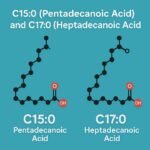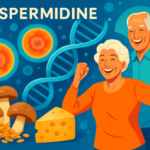Omega-3 fatty acids are essential nutrients known for supporting various aspects of human health. They consist of three primary types: alpha-linolenic acid (ALA), eicosapentaenoic acid (EPA), and docosahexaenoic acid (DHA).
Benefits attributed to omega-3s include:
- Reduced risk of heart disease, particularly by lowering triglyceride levels and potentially increasing HDL (“good”) cholesterol.
- Improved management of autoimmune diseases such as rheumatoid arthritis, lupus, and Crohn’s disease.
- Lowered risk of asthma in children.
- Decreased likelihood of developing certain cancers, including colon, prostate, and breast cancer.
- Enhanced brain function and prevention of age-related mental decline, although further research is required.
- Relief of symptoms related to attention deficit hyperactivity disorder (ADHD) in children1.
- Potential treatment for depression and anxiety, especially when using EPA-rich supplements.
- Reducing inflammation
- Increasing bone strength by boosting calcium absorption, although more research is needed
Some of the best food sources of omega-3 fatty acids include:
Animal Sources:
- Fatty Fish: Salmon, mackerel, sardines, and anchovies are rich in omega-3s like EPA and DHA.
- Shellfish: Oysters, lobster, and scallops are good sources of ALA, DHA, and EPA.
- Walnuts: Walnuts provide ALA omega-3 fatty acids.
Plant Sources:
- Flaxseeds: Flax Seeds are high in ALA omega-3 fatty acids.
- Chia Seeds: Chia seeds are a great plant-based source of ALA omega-3s..
- Brussels Sprouts: Brussels sprouts contain ALA omega-3 fatty acids.
- Soybeans: Dry roasted soybeans are rich in ALA omega-3s.
It’s important to note that while plant-based sources like flaxseeds and chia seeds provide ALA, the body converts this less efficiently to EPA and DHA compared to animal-based sources.. Including a variety of these foods in your diet can help ensure you meet your omega-3 needs for optimal health benefits.
Dosage :
The recommended daily intake of omega-3 fatty acids varies depending on age, sex, and health status. For healthy adults, most health organisations suggest a minimum of 250–500 mg combined EPA and DHA per day. For alpha-linolenic acid (ALA), the recommended intake is 1.6 grams per day for men and 1.1 grams per day for women.. Pregnant and lactating individuals may need additional omega-3s, with recommendations including 0.3 grams of EPA plus DHA during pregnancy and at least 0.2 grams of DHA while lactating.It’s generally advised not to exceed 3 grams of omega-3s per day unless directed otherwise by a healthcare professional. While omega-3 supplements can be beneficial, it’s essential to read labels carefully to ensure you are getting adequate amounts of EPA and DHA.
Differences Between Omega-3 and Omega-6 Fatty Acids
Omega-3 and omega-6 fatty acids are both essential dietary fats with distinct characteristics and functions:
- Structural Difference:
- Omega-3: The first double bond in omega-3 fatty acids occurs on the third carbon atom from the methyl end.
- Omega-6: In omega-6 fatty acids, the first double bond is on the sixth carbon atom from the methyl end.
- Omega-3: Found in animal and plant oils, with prominent sources being oily fish like salmon, mackerel, and plant oils like flaxseed and canola.
- Omega-6: Abundant in our diet, sourced from animal fats and plant oils like sunflower oil.
- Omega-3: Known for supporting heart, brain, and metabolic health, reducing inflammation, and potentially lowering the risk of heart disease.
- Omega-6: Plays a role in regulating genes, promoting immune health, blood clotting, and may help with conditions like rheumatoid arthritis and dermatitis.
- Omega-3: Tends to have anti-inflammatory effects.
- Omega-6: Can promote inflammation when consumed in excess compared to omega-3s.
- Omega-3: Includes ALA, DHA, and EPA.
- Omega-6: Comprises linoleic acid (LA), gamma linolenic acid (GLA), arachidonic acid (ARA), and conjugated linoleic acid (CLA).
Balancing the intake of omega-3 and omega-6 fatty acids is crucial for overall health. While both are essential, an imbalance in their consumption may contribute to chronic diseases. Including a variety of foods rich in both types of fats can help maintain a healthy ratio for optimal well-being. Typical ratio of Omega3:Omega6 should be 1:4 but nowadays due to Processed & Refined foods the ratio has gone up-to 1:20 which is not good and can be responsible for multiple health issues in our body.
What are the risks of consuming too much omega-6 fatty acids
Consuming excessive amounts of omega-6 fatty acids can lead to an imbalanced omega-6 to omega-3 ratio, which may contribute to chronic diseases. High intakes of omega-6 fatty acids, particularly linoleic acid (LA), have been linked to:
- Promoting inflammation, which may raise the risk of various diseases.
- Potentially increasing the risk of heart disease.
- Being converted in the body to arachidonic acid, which can build molecules that promote inflammation, blood clotting, and vasoconstriction..
However, it is essential to consider that omega-6 fatty acids are essential for maintaining good health, and moderate intakes are necessary for proper functioning. An overemphasis on avoiding omega-6 fatty acids is not recommended, as doing so would disrupt the delicate balance required between omega-6 and omega-3 fatty acids. Instead, aim to consume a balanced diet that includes both omega-6 and omega-3 fatty acids, focusing on minimising processed foods and maximising fresh fruits, vegetables, nuts, seeds, and lean protein sources.










